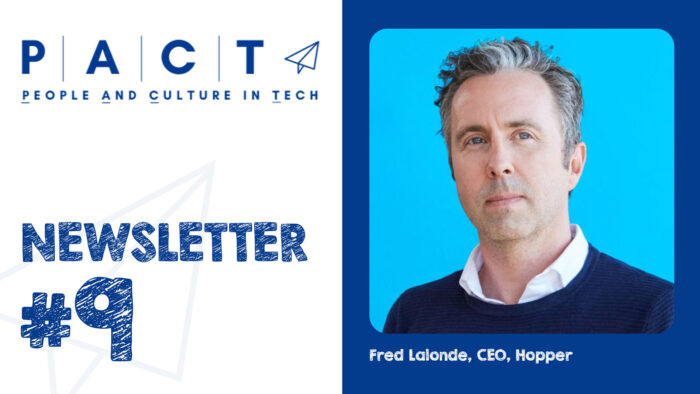Hopper CEO Fred Lalonde explains how to approach culture like a product
Jessica Galang

As CEO Fred Lalonde told us in the SAAS North newsletter, Hopper has a customer-obsessed culture. Among its leadership principles, working backwards based on customer feedback and learnings is key among them — and one that suits Hopper well as they’ve hired hundreds of people to expand their product.
However, building “customer obsession” and efficiency into the culture took some work. When Hopper reached about 150 people, Lalonde noticed that processes were breaking down.
“Everybody I spoke to said ‘it's normal, you're getting bigger. And I just felt that was unacceptable,” says Lalonde. “Deep down, I'm a product guy, so I went on a quest to figure out what I could do.”
At some point, Lalonde realized that they had to design culture as if they were designing a product. It’s an approach adopted by companies like Zappos.com, which uses a Culture Design Canvas to map out its culture based on core values.
Lalonde says these companies treat designing culture as an act of documentation. “At some point, they got big, and they said, who are we and what are our values?” He says. “They wrote that down, And they said, ‘here's who we are.’”
Designing culture
To design a customer-obsessed culture, companies can ask themselves questions like what culture they should have to have a competitive advantage and better serve customers, Lalonde says.
“When you ask the question that way, what you're saying is there's such a thing as culture-market fit, which is the same thing as product-market fit, except it's about how you design your culture,” Lalonde says.
Based on that question, Lalonde said he started approaching culture as if it was an operating system. “It should be active in the same way that the operating system controls how applications access the memory of your cell phone or your computer. The reason it exists is to prevent collisions and resources being consumed in chaotic ways that leads to the whole thing collapsing.”
“Somebody that has ownership doesn't have to get permission to do something, so you end up with a loosely bound federation of internal startups.”
While onboarding employees takes time and resources, this sort of system — strong documentation and clarity on culture-market fit — has helped set clearer expectations for new employees. This helps tackle the stressful experience of figuring out how things work, and managing expectations of new hires that aren’t accustomed to the existing culture and employees.
“[If] you don't have a system to actually tell them how they should behave to be rewarded and be successful, an active system that is designed with your customer in mind, you get chaos,” says Lalonde.
Single-threaded ownership
When it comes to accountability, Hopper adopts the idea of single-threaded ownership, a practice widely credited to Amazon: having one owner dedicated to one deliverable business outcome, empowered to do what they can to get things done without having to wait for decisions from senior leaders or other stakeholders.
“Somebody that has ownership doesn't have to get permission to do something, so you end up with a loosely bound federation of internal startups,” Lalonde says. “We don't have an engineering group. We don't have a product team, we don't have a head of product, we don't have a head of design.”
“If you put smart people and you give them autonomy and ownership, what you end up getting is a lot of implicit collaboration.”
Hopper says this approach suits the company because it’s fast and focused on the customer. When companies get bigger, they tend to have more stakeholders and more processes, which can slow down the process. Lalonde acknowledges that, from the outside, it seems like there would be disjointed user interfaces or other challenges caused by a communication breakdown. But, he finds the team members will collaborate on code or design that works in order to get their own projects done.
“If you put smart people and you give them autonomy and ownership, what you end up getting is a lot of implicit collaboration,” Lalonde says. “Smart people will imitate very quickly.”
Time well spent
This idea of autonomy and ownership extends to how Hopper expects employees to use their time. They expect leaders to have free calendars for most of the time, and use that time to talk to customers rather than hosting many meetings.
“If you have people working for you who get half an hour with you every two weeks, if that person can't function with that level of access to you, you need to do something about that,” Lalonde says.
In Lalonde’s case, because he’s saving time on meetings, he has time to look at analytics or other areas of the business and study them so that he can actually be useful to employees he’s working with, and have a full understanding of what’s happening in the business. That means he can support employees in a meaningful way.
“I have time to dig into the data, I have time to sit down with somebody that's struggling and say what's going on, and what can I do for you?” he says.
BACK








